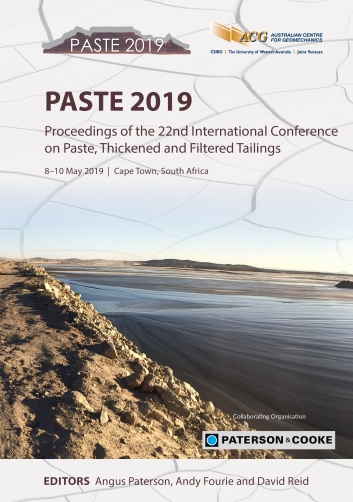Required strength evaluation model and its application for vertically exposed backfill: inspired by Mitchell’s physical model tests

|
Authors: Liu, GS; Yang, XC; Pan, A; Guo, LJ; Li, L |
DOI https://doi.org/10.36487/ACG_rep/1910_33_Liu
Cite As:
Liu, GS, Yang, XC, Pan, A, Guo, LJ & Li, L 2019, 'Required strength evaluation model and its application for vertically exposed backfill: inspired by Mitchell’s physical model tests', in AJC Paterson, AB Fourie & D Reid (eds), Paste 2019: Proceedings of the 22nd International Conference on Paste, Thickened and Filtered Tailings, Australian Centre for Geomechanics, Perth, pp. 451-463, https://doi.org/10.36487/ACG_rep/1910_33_Liu
Abstract:
Cemented paste backfill is an increasingly popular technique to improve ground stability in underground mines. This technique is used in several mining methods that require strength evaluation for the vertically exposed cemented backfill following the excavation of an adjacent stope on one side. The critical strength is generally evaluated with an analytical solution proposed by Mitchell et al. (1982). Despite its wide acceptance in academia and application in the mining industry, the Mitchell solution has received only a few updates in the literature, including some new developments given by the authors and colleagues. The original Mitchell solution and its variants were mainly validated against the physical model test results obtained by Mitchell et al. (1982). Even though the Mitchell model debatably assumed a zero backfill friction angle, the required strengths predicted by the Mitchell solution corresponded quite well to those obtained by physical model tests. This study reanalysed the Mitchell solution and its physical model. The testing conditions and procedures for measuring the shear strength parameters are investigated. The stability of the cemented backfill upon removal of a confining wall is analysed with FLAC3D. The comparisons between the numerical modellings, experimental results and analytical solutions are presented, and the applicable range of the classical Mitchell solution is discussed. A new analytical solution is proposed to evaluate the minimum required strength of the cemented backfill confined by two sidewalls exposed on one side and subject to pressure from uncemented backfill on the opposite side. The proposed analytical solution is validated by numerical simulations with FLAC3D. The proposed analytical solution is used to determine the theoretical strength requirement of cemented backfill in primary stopes of an iron mine that employs stage stoping with subsequent backfill mining. The floating Factor of Safety (FS) characterising the current backfilling quality control level of this mine was statistically evaluated with a large amount of uniaxial compressive strength (UCS) data after testing vast drilled samples from field stopes. The engineered strength requirement of the cemented backfill in primary stopes had been finalised by combining the analytical results and floating FS of the mine.
Keywords: cemented backfill, required strength, Mitchell, physical model tests, FLAC3D
References:
Arioglu, E 1984, ‘Design aspects of cemented aggregate fill mixes for tungsten stoping operations’, Mining Science and Technology, vol. 1, no. 3, pp. 209–214.
Chen, LJ & Jiao, DY 1991, ‘A design procedure for cemented fill for open stoping operations’, Mining Science and Technology, vol. 12, no. 3, pp. 333–343.
Darling, P 2011, SME Mining Engineering Handbook, 3rd edn, Society for Mining Metallurgy & Exploration Inc., Littleton.
Dirige, APE, McNearny, RL & Thompson, DS 2009, ‘The effect of stope inclination and wall rock roughness on back-fill free face stability’, in M Diederichs & G Grasselli (eds), Rock Engineering in Difficult Conditions, Proceedings of the 3rd Canada–US Rock Mechanics Symposium, Toronto, paper 4152.
Duncan, JM & Wright, SG 2005, Soil Strength and Slope Stability, John Wiley & Sons, Hoboken.
El Mkadmi, N, Aubertin, M & Li, L 2014, ‘Effect of drainage and sequential filling on the behaviour of backfill in mine stopes’, Canadian Geotechnical Journal, vol. 51, no. 1, pp. 1–15.
Li, L 2014a, ‘Generalized solution for mining backfill design’, International Journal of Geomechanics, vol. 14, no. 3.
Li, L 2014b, ‘Analytical solution for determining the required strength of a side-exposed mine backfill containing a plug’, Canadian Geotechnical Journal, vol. 51, no. 5, pp. 508–519.
Li, L & Aubertin, M 2012, ‘A modified solution to assess the required strength of exposed backfill in mine stopes’, Canadian Geotechnical Journal, vol. 49, no. 8, pp. 994–1002.
Li, L & Aubertin, M 2014, ‘An improved method to assess the required strength of cemented backfill in underground stopes with an open face’, International Journal of Mining Science and Technology, vol. 24, no. 4, pp. 549–558.
Mitchell, RJ, Olsen, RS & Smith, JD 1982, ‘Model studies on cemented tailings used in mine backfill’, Canadian Geotechnical Journal, vol. 19, no. 1, pp. 14–28.
Thompson, BD, Bawden, WF & Grabinsky, MW 2012, ‘In situ measurements of cemented paste backfill at the Çayeli Mine’, Canadian Geotechnical Journal, vol. 49, no. 7, pp. 755–772.
Zou, S & Nadarajah, N 2006, ‘Optimizing backfill design for ground support and cost saving’, Golden Rocks 2006, Proceedings of the 41st US Symposium on Rock Mechanics (USRMS), American Rock Mechanics Association, Alexandria, pp. 7–21.
© Copyright 2025, Australian Centre for Geomechanics (ACG), The University of Western Australia. All rights reserved.
View copyright/legal information
Please direct any queries or error reports to repository-acg@uwa.edu.au
View copyright/legal information
Please direct any queries or error reports to repository-acg@uwa.edu.au


